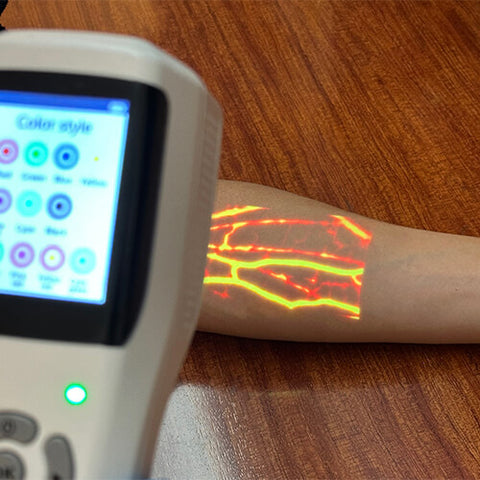1.What is Vein visualization?

Vein visualization uses Near-infrared(NIR) light to detect veins It is an innovative technology that assists healthcare professionals with finding the best veins for IV starts and blood draws, also known as vein mapping. This creates a real-time visual “map” of the veins on the surface of the skin by projecting images using deoxygenated hemoglobin absorption in NIR light waves. Veins have high amounts of this type of pigment which allows us to see them via projection from devices like these ones used at hospitals or phlebotomist clinics today!
Vein visualization is growing due to its increasing popularity among medical staff who are able better avoid complications during venipuncture procedures thanks to its use!
2. The origin of venous visualization technology
In 2013, INS convened a task force of infusion therapy specialists to make recommendations on how healthcare professionals can improve puncture success in their practice. Their findings included their recommendations for patients with difficult or poor venous access, defined as "at least 50% intravenous catheter advancement at first insertion in adults"; in these cases, they recommend the use of venous visualization techniques such as ultrasound systems.
The report of the study results includes stronger visualization guidelines than the previous iteration to improve the safety of care for patients who have difficulty accessing veins, such as those who are obese or have darker skin. This is because these techniques include illuminated catheters that allow doctors to easily access deeper veins that if not used they may miss completely or puncture incorrectly - which will result in failure and increased discomfort/pain.
3.How Does the Vein Visualization Technology Work?
The basic technology that most vein detectors use is an infrared wave, or Near-infrared light (NIL), infrared light reacts differently to blood and tissue and when it hits blood, it absorbs it and doesn't reflect it back. That's because hemoglobin or proteins in the blood that carries oxygen, absorb the light.
On the other hand, when an infrared wave hits a vein, artery or tissue, it bounces back. Reflex properties allow vein finders to create images of your veins, tissues, and blood, right under your skin. Usually, these images are red, blue, green, and so on. Generally, your Settings will determine the color you see. You'll see veins bright, blood and other tissues black or white, and most vein finders allow you to reverse the image.
4.Why use the Vein Visualization Technology?
In the decade since venous visualization emerged, doctors and nurses have become more transparent in their piercing practices. Venous visualization provides doctors and nurses with images of blood vessels, making it easier to evaluate and find appropriate venous fluid or draw blood.
The technology allows users to see blood patterns up to 15 millimeters deep and clinically relevant veins up to 10 millimeters deep. Not only that, the clinician can see surrounding veins, branches, and valves and assess venous reperfusion/flushing in real-time.
Aimvein said the device increased the success rate of the first puncture by 3.5 times, reduced the number of patients requiring indwells, and reduced the pain of the puncture patient by 39 percent.
5. Why choose aimvein Vein Visualization Technology?

An objective Vein is an important tool for safe and effective venipuncture operation. Without this device, patients undergoing venipuncture could be at risk!
- Light, comfortable, and easy to use
- Suitable for all ages, weights, and skin tones
- Helps locate and evaluate veins
- Transfusion Nurse Safety Recommendation Certification Technology (INS)
- Hospital-grade device
- Reduce the patient's discomfort and anxiety.
- High-cost performance






Was this written by a very stupid AI? Compare these sentences. “…Infrared light reacts differently to blood and tissue and when it hits blood, it absorbs it and doesn’t reflect it back.”.
“…When an infrared wave hits a vein, artery or tissue, it bounces back.”
So, is IR reflected or absorbed by a vein? Your “article” suggests that both phenomena happen with a vein containing blood. Is there any other kind of vein in vitro?